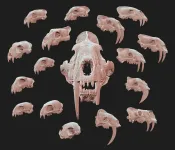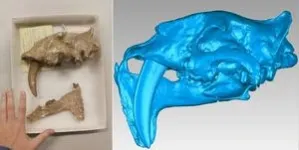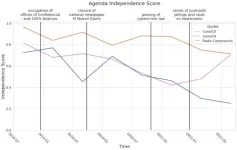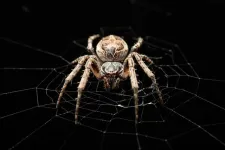(Press-News.org) In a groundbreaking study, an international team led by scientists from the University of Liège has investigated the evolutionary patterns behind the development of sabre teeth, with some unexpected results along the way. A study that enriches our understanding of the Earth's past, but also documents the mechanisms leading to evolutionary convergence.
Sabre teeth, those iconic elongated upper canine teeth, have long fascinated both scientists and the general public, notably because they have appeared several times in the fossil record, including two particularly well-known lineages of sabre-toothed tigers: the felids (the family of our domestic cats, lions, tigers, etc.) and the nimravids (a completely extinct family). However, the process by which these lineages acquired their elongated upper canines remains rather unclear.
Narimane Chatar, lead author of the study, who completed her doctorate at the EDDy Lab at the University of Liège and is now a post-doctoral fellow at UC Berkeley in the United States, has led an ambitious study to uncover the secrets of sabre tooth evolution. Using state-of-the-art 3D scanners and analytical methods, the team meticulously collected and analysed data from a diverse set of current and extinct species. "We quantified the shape of 99 mandibles and 91 skulls, from different eras and continents, giving us a better understanding of the evolution of these animals," explains Dr Chatar. "Unlocking the secrets of sabre tooth evolution not only enriches our understanding of the Earth's past, but also documents the mechanisms leading to evolutionary convergence," says Professor Valentin Fischer, Director of the EDDyLab at ULiège.
The study revealed some surprising results. The first is that rather than contrasting two distinct cranial morphologies in species with elongated upper canines and those with short teeth, there is instead a continuum of form linking the smallest present-day cats and their extinct sabre-toothed counterparts. "From a morphological point of view, the skull of a present-day small cat is just as strange and modified as that of a large sabre-toothed felid," says Dr Margot Michaud, a researcher at the University of French Guyana in Cayenne. These are therefore the two extremes of a continuum of forms that feline predators have seen evolve over geological time. "Our study suggests that what we often think of as examples of evolutionary patterns in textbooks are actually simplified for educational purposes. However, when we immerse ourselves in statistical analyses, we discover much more complex scenarios in these cases, as suggested by the results of our convergence tests", explains Davide Tamagnini, post-doctoral researcher at the University of Rome La Sapienza.
The second surprise concerns the path taken by evolution to produce sabre-toothed species. In fact, the team's work has revealed that sabre-toothed species show faster rates of morphological evolution at the start of their evolutionary history than species with shorter canines. "Among other fascinating discoveries, we have shown that craniomandibular integration in sabre-toothed species is reduced, facilitating greater adaptability and diversification in the jaw and cranial morphology," points out Margot Michaud. Thus, rapid morphological diversification and a fairly plastic skull have been identified as two key components that facilitated the emergence of elongated upper canines in both felids and nimravids. "As a result, there appears to be a common recipe for evolving into sabre-toothed feline-like predators," says Dr Chatar.
Finally, the team's research highlighted the decline of sabre-toothed forms as well as the broader trends of feline-like predators over the course of their evolutionary history. Despite the relatively recent extinction of sabre-toothed forms 'only' a few thousand years ago, feline predators have in fact been in decline since the Miocene epoch (between -23 and -5 million years ago). "Some of these feline predators, particularly the sabre-toothed species, rapidly occupied fairly specialised niches, which made them more susceptible to extinction", explains Dr Tamagnini. This phenomenon, known as 'ratchet' or macroevolutionary ratchet, has been proposed as a potential driver for the decline of certain groups, where evolution favours the loss of early generalised forms, leading to the emergence of more specialised, but also more vulnerable, forms later in the history of the lineage.
"Predators have their own evolutionary pathways and risks of extinction. Studying how ancient predators prospered and declined provides us with information about the possible futures of our ecosystems", concludes Professor Fischer.
END
How did sabre-toothed tigers acquire their long upper canine teeth?
A study that enriches our understanding of the Earth's past and documents the mechanisms leading to evolutionary convergence.
2024-05-16
ELSE PRESS RELEASES FROM THIS DATE:
End-of-life systemic treatment for patients with advanced cancers does not improve survival
2024-05-16
Patients with very advanced solid tumors saw no significant improvement in overall survival after receiving systemic therapy, according to a study published today in JAMA Oncology by researchers at The University of Texas MD Anderson Cancer Center and Yale Cancer Center.
The findings provide further evidence to help oncologists counsel patients that additional cancer-directed therapy is not likely to benefit them, allowing them to focus instead on palliative and supportive care options that have been demonstrated ...
To optimize guide-dog robots, first listen to the visually impaired
2024-05-16
May 16, 2024
To Optimize Guide-Dog Robots, First Listen to the Visually Impaired
Award-winning research led by UMass Amherst shows to be successful, Guide-dog users and trainers need to provide insight into features that make robotic helpers useful in the real world
AMHERST, Mass. — What features does a robotic guide dog need? Ask the blind, say the authors of an award-winning paper. Led by researchers at the University of Massachusetts Amherst, a study identifying how to develop robot guide dogs with insights from guide dog users and trainers won a Best Paper Award at ...
Imaging fibrous structure abnormalities of the white of the eye in myopathic patients
2024-05-16
Researchers provide an innovative approach to understanding ocular pathologies by visualizing the fiber structure of the sclera, the outermost eye layer
Tokyo, Japan – Eye diseases are extremely prevalent worldwide, with recent estimates suggesting that one-third of the global population suffers from some type of vision impairment. Given the high complexity of the human eye, the precise origin and nature of many eye diseases remain unclear, leaving affected people with limited diagnostic and treatment options.
Now, in a study made available online on March 7, 2024 and published in Volume 142, Number 4 of JAMA Ophthalmology on ...
Loneliness and mental health problems are interconnected
2024-05-16
“We have found a correlation between loneliness and several mental health problems,” says Associate Professor Rubén Rodríguez-Cano at the Norwegian University of Science and Technology (NTNU’s) Department of Psychology.
In a new study, researchers are looking at whether lonely people are more prone to problems such as depression and psychosis. Based on medication use, the correlation is clear.
“The risk of a lonely person also struggling with mental health problems is greater than for people who ...
Dr. Daniel Geynisman named new Editor-in-Chief for JNCCN—Journal of the National Comprehensive Cancer Network
2024-05-16
PLYMOUTH MEETING, PA [May 16, 2024] — Daniel M. Geynisman, MD, is being announced as the new Editor-in-Chief for JNCCN—Journal of the National Comprehensive Cancer Network. Dr. Geynisman has a long history of working with NCCN in a variety of roles and served as medical oncology section editor for Urologic Oncology: Seminars and Original Investigations since 2018 and authored more than 130 peer-reviewed publications. He is an Associate Professor in the Department of Hematology/Medical Oncology and Chief of the Division of Genitourinary Medical Oncology at Fox Chase Cancer Center.
“We are thrilled to welcome Dr. Geynisman into this ...
A new and better way to detect media censorship
2024-05-16
Worldwide news media are facing increasing pressure from autocrats to report favourably about their leaders and party politics. Political scientists launch a new computational method that can detect such media censorship by states while it is happening. This method provides valuable insights for communicating regime-driven media capture to the public. It is now described in detail in the scientific journal ‘Democratization’.
One of the first steps of would-be autocrats is to control the ...
Listening to muscles
2024-05-16
Spinal muscular atrophy or “SMA” for short is a terrible disease in which a genetic mutation causes certain nerves responsible for sending signals to muscles to degenerate. This leads to muscles wasting away, and many patients have died a painful death due to this rare condition. Genetic treatments have only been available for a few years. Now, a team led by Emmanuel Nedoschill, Ferdinand Knieling and Adrian Regensburger from the “Translational Pediatrics” working group at the Department of Pediatrics and Adolescent Medicine at Uniklinikum Erlangen have devised ...
Spider silk sound system #ASA186
2024-05-16
OTTAWA, Ontario, May 16, 2024 – The best microphone in the world might have an unexpected source: spider silk. Spiders weave webs to trap their insect snacks, but the sticky strands also help spiders hear. Unlike human eardrums and conventional microphones that detect sound pressure waves, spider silk responds to changes in the velocities of air particles as they are thrust about by a sound field. This sound velocity detection method remains largely underexplored compared to pressure sensing, but it holds great potential for high-sensitivity, long-distance sound detection.
Researchers ...
Equitable opportunity for transplants: Experts provide disparity-sensitive measures for transplant centers
2024-05-16
INDIANAPOLIS – An Expert Insight, published in the journal Transplantation, highlights health equity, disparity and inequality in organ transplantation along the continuum of care and across organ types. The authors provide a guide to transplant centers for the use of disparity-sensitive measures to monitor and address health disparities in transplantation and to redress long-standing inequities and inequalities in this vital arena.
“Our goal is to ensure that all patients who need a transplant have ...
Gene therapy relieves back pain, repairs damaged disc in mice
2024-05-16
COLUMBUS, Ohio – Disc-related back pain may one day meet its therapeutic match: gene therapy delivered by naturally derived nanocarriers that, a new study shows, repairs damaged discs in the spine and lowers pain symptoms in mice.
Scientists engineered nanocarriers using mouse connective-tissue cells called fibroblasts as a model of skin cells and loaded them with genetic material for a protein key to tissue development. The team injected a solution containing the carriers into damaged discs in mice at the same time the back injury ...
LAST 30 PRESS RELEASES:
Australian team discover why quantum computers have memory problems over time
What determines the fate of a T cell?
Candida auris: genetic process revealed which could be treatment target for deadly fungal disease
Groundbreaking discovery turns household plastic recycling into anti-cancer medication
Blocking a key inflammatory pathway improves liver structure and vascular function in cirrhosis, study finds
Continuous spread: Raccoon roundworm detected in nine European countries
HKUST Engineering researchers developed a novel photodetector to enhance the performance of on-chip light monitoring
Strategic river sensors could have forewarned of Texas Camp flood disaster
Drone sampling of whale breath reveals first evidence of potentially deadly virus in Arctic
Roman soldiers defending Hadrian’s Wall infected by parasites, study finds
Pinochet’s prisoners were tormented with music but still found solace in it, a new book reveals
Fertility remains high in rural Tanzania despite access to family planning
AI-assisted device can improve autism care access
Kinetic careers
Uncovering how parasitic plants avoid attacking themselves to improve crop resistance
Nanoparticle vaccine strategy could protect against Ebola and other deadly filoviruses
Study finds brain care score can predict risk of stroke across racial groups
Key lung immune cells can intensify allergic reactions
Do hormones explain why women experience more gut pain?
New materials conduct ions in solids as easily as in liquids
Breakthrough of the Year: Renewable energy begins to eclipse fossil fuel-based sources
LLM use is reshaping scientific enterprise by increasing output, reducing quality and more
Introducing LightGen, a chip for ultra-fast, ultra-efficient generative AI
Astronomers see fireworks from violent collisions around nearby star
ACC/AHA issue new guideline on managing congenital heart disease in adults
Cosmic crash caught on camera
Is talented youth nurtured the wrong way? New study shows: top performers develop differently than assumed
Ants: An untapped resource in the development of antibiotics?
Archaeologists use AI to create prehistoric video game
Mitochondria migrate toward the cell membrane in response to high glucose levels
[Press-News.org] How did sabre-toothed tigers acquire their long upper canine teeth?A study that enriches our understanding of the Earth's past and documents the mechanisms leading to evolutionary convergence.







